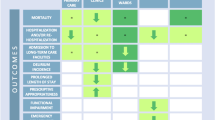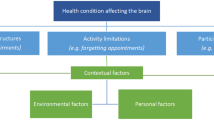Abstract
Objectives
No guidance currently exists as to the cognition threshold beyond which self-reported quality of life for older people with cognitive impairment and dementia is unreliable.
Methods
Older aged care residents (≥ 65 years) were randomly assigned to complete the EQ-5D-5L in computer-based (eye movements were tracked) or hard copy (participants were encouraged to ‘think aloud’) format. Cognition was assessed using the Mini-Mental State Examination (MMSE). Think aloud and eye tracking data were analysed by two raters, blinded to MMSE scores. At the participant level, predefined criteria were used to assign traffic light grades (green, amber, red). These grades indicate the extent to which extracted data elements provided evidence of self-report reliability. The MMSE-defined cognition threshold was determined following review of the distributions of assigned traffic light grades.
Results
Eighty-one residents participated and provided complete data (38 eye tracking, 43 think aloud). In the think aloud cohort, all participants with an MMSE score ≤ 23 (n = 10) received an amber or red grade, while 64% of participants with an MMSE score ≥ 24 (21 of 33) received green grades. In the eye tracking cohort, 68% of participants with an MMSE score ≥ 24 (15 of 22) received green grades. Of the 16 eye tracking participants with an MMSE score ≤ 23, 14 (88%) received an amber or red grade.
Conclusions
Most older residents with an MMSE score ≥ 24 have sufficient cognitive capacity to self-complete the EQ-5D-5L. More research is needed to better understand self-completion reliability for other quality-of-life instruments in cognitively impaired populations.
Similar content being viewed by others
References
United Nations Department of Economic and Social Affairs, Population Division (2020). World population ageing 2020 highlights: living arrangements of older persons (ST/ESA/SER. A/451)
Australian Institute of Health and Welfare. Admitted patient care 2017–18: Australian hospital statistics. Canberra: Australian Government; 2019.
World Health Organisation. Integrated care for older people. Geneva: World Health Organisation; 2018.
Australian Institute of Health and Welfare. Gen aged care data: government spending on aged care. Canberra: Australian Government; 2020.
Department of Health and Aged Care. New residential aged care quality indicators. Australian Government, Canberra, 21 Sept. 2021.
Agarwal A, Pain T, Levesque J, et al. Patient-reported outcome measures (PROMs) to guide clinical care: recommendations and challenges. Med J Aust. 2022;216(1):9–11.
Sabah S, Knight R, Alvand A, Beard D, Price A. Early patient-reported outcomes from primary hip and knee arthroplasty have improved over the past seven years: an analysis of the NHS PROMs dataset. Bone Jt J. 2022;104-B(6):687–95.
Organisation for Economic Cooperation and Development (OECD). All hands on deck: Co-developing the first international survey of people living with chronic conditions - Stakeholder engagement in the design, development, and field trial implementation of the PaRIS survey, OECD Health Working Paper No. 149, Jan. 2023.
Ernstsson O, Janssen M, Heintz A. Collection and use of EQ-5D for follow-up, decision-making, and quality improvement in health care-the case of the Swedish National Quality Registries. J Patient Report Outcomes. 2020;4:78.
Dean S, Al Sayah F, Johnson J. Measuring value in healthcare from a patients' perspective. J Patient Report Outcomes. 2021;5(Suppl 2):88.
Timmons S, Manning E, Barrett A, et al. Dementia in older people admitted to hospital: a regional multi-hospital observational study of prevalence, associations and case recognition. Age Ageing. 2015;44(6):993–9.
Australian Institute of Health and Welfare. Dementia in Australia. Canberra: Australian Government; 2023.
O’Shea E, Hopper L, Marques M, et al. A comparison of self and proxy quality of life ratings for people with dementia and their carers: a European prospective cohort study. Aging Ment Health. 2020;24(1):162–70.
Sousa M, Santos R, Simoes P, Conde-Sala J, Dourado M. Discrepancies between Alzheimer’s disease patients’ and caregivers’ ratings about patients’ quality of life. Alzheimer Dis Assoc Disord. 2018;32(3):240–6.
Hutchinson C, Worley A, Khadka J, Milte R, Cleland J, Ratcliffe J. Do we agree or disagree? A systematic review of the application of preference-based instruments in self and proxy reporting of quality of life in older people. Soc Sci Med. 2022;305: 115046.
Ayton D, Gardam M, Pritchard E, et al. Patient-reported outcome measures to inform care of people with dementia-a systematic scoping review. The Gerontologist. 2021;61(5):e185–94.
Brazier J, Ratcliffe J, Salomon J, Tsuchiya A. Measuring and valuing health benefits for economic evaluation. 2nd ed. Oxford: Oxford University Press; 2017.
Herdman M, Gudex C, Llloyd A, Janssen M, Kind P, Parkin D, Bonszel G, Badia X. Development and preliminary testing of the new five-level version of EQ-5D (EQ-5D-5L). Qual Life Res. 2011;20:1727–36.
Lay K, Crocker M, Engel L, Ratcliffe J, Charlton S, Hutchinson C. How do older adults receiving aged care services understand and respond to the EQ-5D-5L? A think aloud study in residential care. Qual Health Res. 2023;32(11):3161–70.
Milte R, Crocker M, Lay K, Ratcliffe J, Mulhern B, Norman R, Viney R, Khadka J. Feasibility of self-reported health related quality of life assessment with older people in residential care: insights from the application of eye tracking technology. Qual Life Res. 2023;32(12):3557–69.
Hennink M, Kaiser B, Marconi V. Code saturation versus meaning saturation: how many interviews are enough? Qual Health Res. 2017;27(4):591–608.
Wang K, Barr C, Norman R, George S, Whitehead C, Ratcliffe J. Using eye tracking technology with older people in memory clinics to investigate the impact of mild cognitive impairment on choices for EQ-5D-5L health states preferences. Appl Health Econ Health Policy. 2021;19(1):111–21.
Cullen B, Evans J, Coen R, et al. A review of screening tests for cognitive impairment. J Neurol Neurosurg Psychiatry. 2007;78:790–9.
Kahle-Wrobleski K, Corrada M, Li B, Kawas C. Sensitivity and specificity of the Mini-Mental State Examination for identifying dementia in the oldest-old: the 90+ Study. J Am Geriatr Soc. 2007;55(2):284–9.
National Institute for Health and Care Excellence. Donepezil, galantamine, rivastigmine and memantine for the treatment of Alzheimer’s disease. Technology appraisal guidance June 2018.
Van den Haak M, De Jong M, Schellnes P. Retrospective vs concurrent think aloud protocols: testing the usability of an online library catalogue. Behav Inform Technol. 2003;22(5):339–51.
Whitty J, Walker R, Golenko X, Ratcliffe J. A think aloud study comparing the validity and acceptability of discrete choice and best worst scaling methods. PLoS ONE. 2014;9(4):e90635.
Tobii Pro. Tobii Pro Eye Tracker Manager. 2017. https://www.tobiipro.com/product-listing/eye-tracker-manager/. Accessed 12 July 2023.
Staub A, Rayner K. Eye movements and on-line comprehension processes. In: Gaskill G, editor. the Oxford Handbook of psycholinguistics. Oxford University Press; 2007. p. 327–42.
Guerriero C, Abrines Jaume N, Diaz-Ordaz K, Brown K, Wray J, Ashworth J, Abbiss M, Cairns J. Using animation to self-report health: a randomized experiment with children. The Patient. 2020;13:175–88.
Hutchinson C, Ratcliffe J, Cleland J, Walker R, Milte R, McBain C, Corlis M, Cornell V, Khadka J. The integration of mixed methods data to develop the quality of life-aged care consumers (QOL-ACC) instrument. BMC Geriatr. 2021;21(1):702.
Keetharuth A, Taylor Buck E, Acquadro C, Conway K, Connell J, Barkham M, Carlton J, Ricketts T, Barber R, Brazier J. Integrating qualitative and quantitative data in the development of outcome measures: the case of the recovering quality of life (ReQoL) measures in mental health populations. Int J Environ Res Public Health. 2018;15(7):1342.
Tourangeau R, Bradburn N. The psychology of survey response. In: Marsden P, Wright J, editors. Handbook of survey research. 2nd ed. Emerald publishing group; 2009. p. 315–46.
Beer C, Flicker L, Horner B, et al. Factors associated with self and informant ratings of the quality of life of people with dementia living in care facilities: a cross sectional study. PLoS ONE. 2010;5(12): e15621.
Burks H, des Bordes J, Chadha R, Holmes H, Rianon N. Quality of life assessment in older adults with dementia: a systematic review. Dement Geriatr Cognit Disord. 2021;50:103–10.
Neumann P, Sander G, Russell L, Seigel J, Ganiats T. Cost-effectiveness in health and medicine. Oxford, UK: Oxford University Press; 2016.
Basch E. New frontiers in patient-reported outcomes: adverse event reporting, comparative effectiveness, and quality assessment. Annu Rev Med. 2014;65:307–17.
Lavallee D, Chenok K, Love R, Petersen C, et al. Incorporating patient-reported outcomes into health care to engage patients and enhance care. Health Aff. 2016;35:575–82.
US Preventive Services Task Force. Screening for cognitive impairment in older adults. US Preventive Services Task Force Recommendation Statement. JAMA. 2020;323(8):757–63.
World Health Organisation and Alzheimers Diseases International. Dementia: a public health priority. Berlin: World Health Organisation; 2012.
Griffiths A, Smith S, Martin A, Meads D, Kelley R, Surr C. Exploring self-report and proxy-report quality-of-life measures for people living with dementia in care homes. Qual Life Res. 2020;29:463–72.
Acknowledgements
We would like to thank all the older people who generously gave up their time to participate in this study.
Author information
Authors and Affiliations
Corresponding author
Ethics declarations
Funding
This work was supported by a research grant awarded by the EuroQoL Foundation.
Contributors
JR, LE, RM, CH, JK, DW, BM, RV and RN conceptualised this study. KL and MC led the study design and analysis with contributions from JR, LE, RM, CH, JK, DW, BM, RV and RN. JR wrote the first draft. All authors provided feedback on the first draft and agreed on the final draft. All authors reviewed and approved the final amendments. JR acts as guarantor.
Competing Interests
All authors declare no conflicts of interest.
Ethical Approval
This study was approved by the Social and Behavioural Research Ethics Committee at Flinders University (approval no: 6732).
Data Availability Statement
The dataset underpinning this research is available upon request from the study authors.
Supplementary Information
Below is the link to the electronic supplementary material.
Rights and permissions
Springer Nature or its licensor (e.g. a society or other partner) holds exclusive rights to this article under a publishing agreement with the author(s) or other rightsholder(s); author self-archiving of the accepted manuscript version of this article is solely governed by the terms of such publishing agreement and applicable law.
About this article
Cite this article
Ratcliffe, J., Lay, K., Crocker, M. et al. Unravelling the Self-Report Versus Proxy-Report Conundrum for Older Aged Care Residents: Findings from a Mixed-Methods Study. Patient 17, 53–64 (2024). https://doi.org/10.1007/s40271-023-00655-6
Accepted:
Published:
Issue Date:
DOI: https://doi.org/10.1007/s40271-023-00655-6




